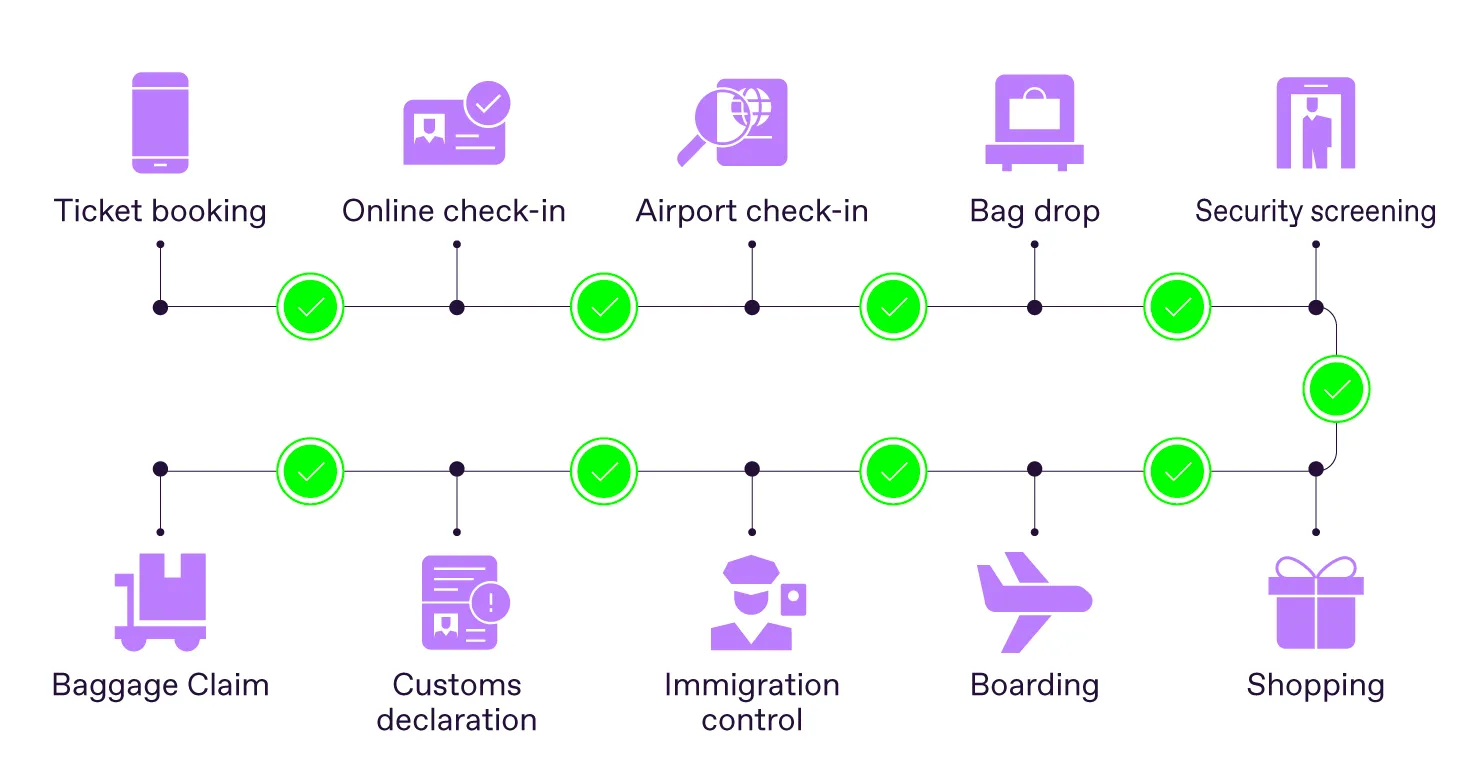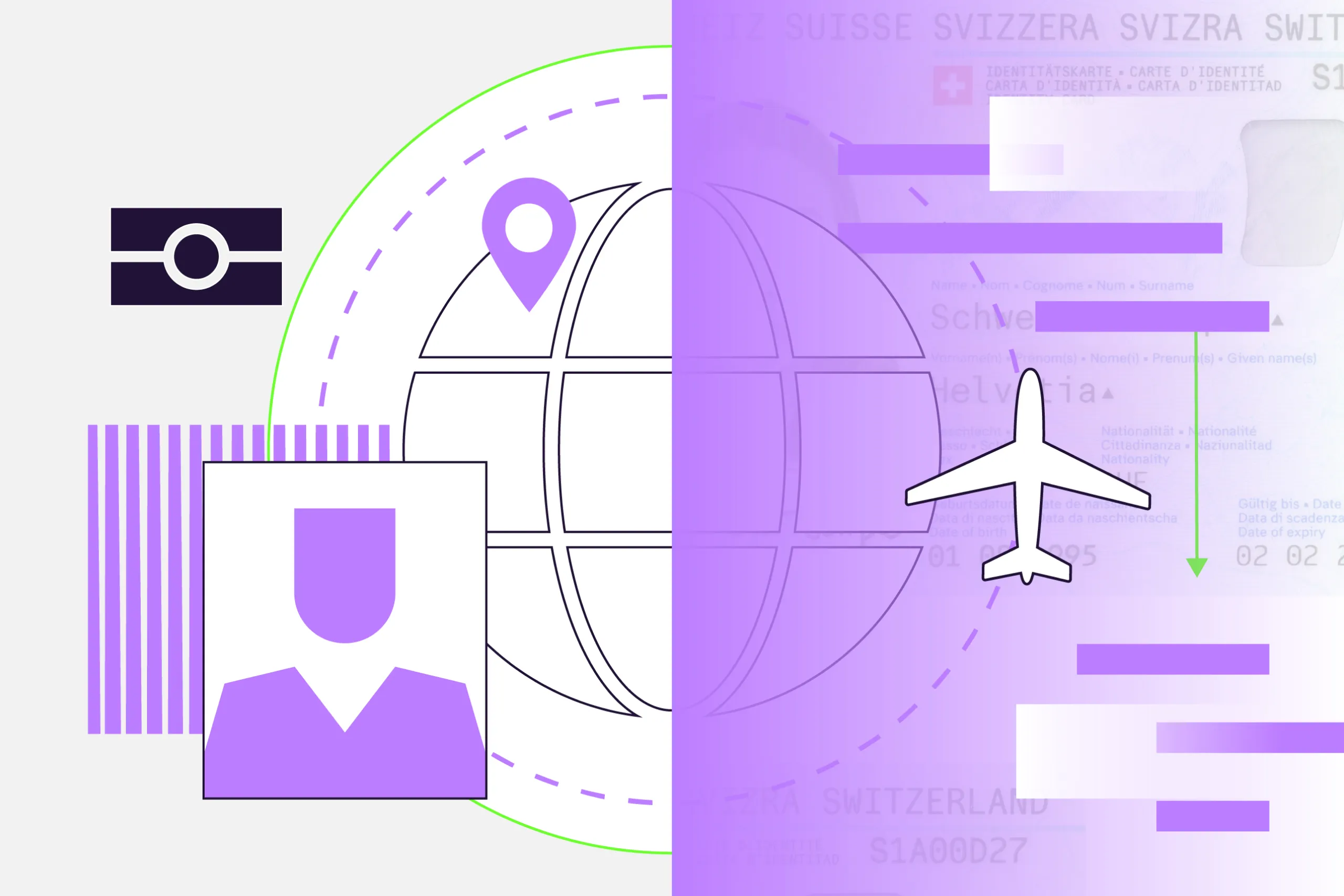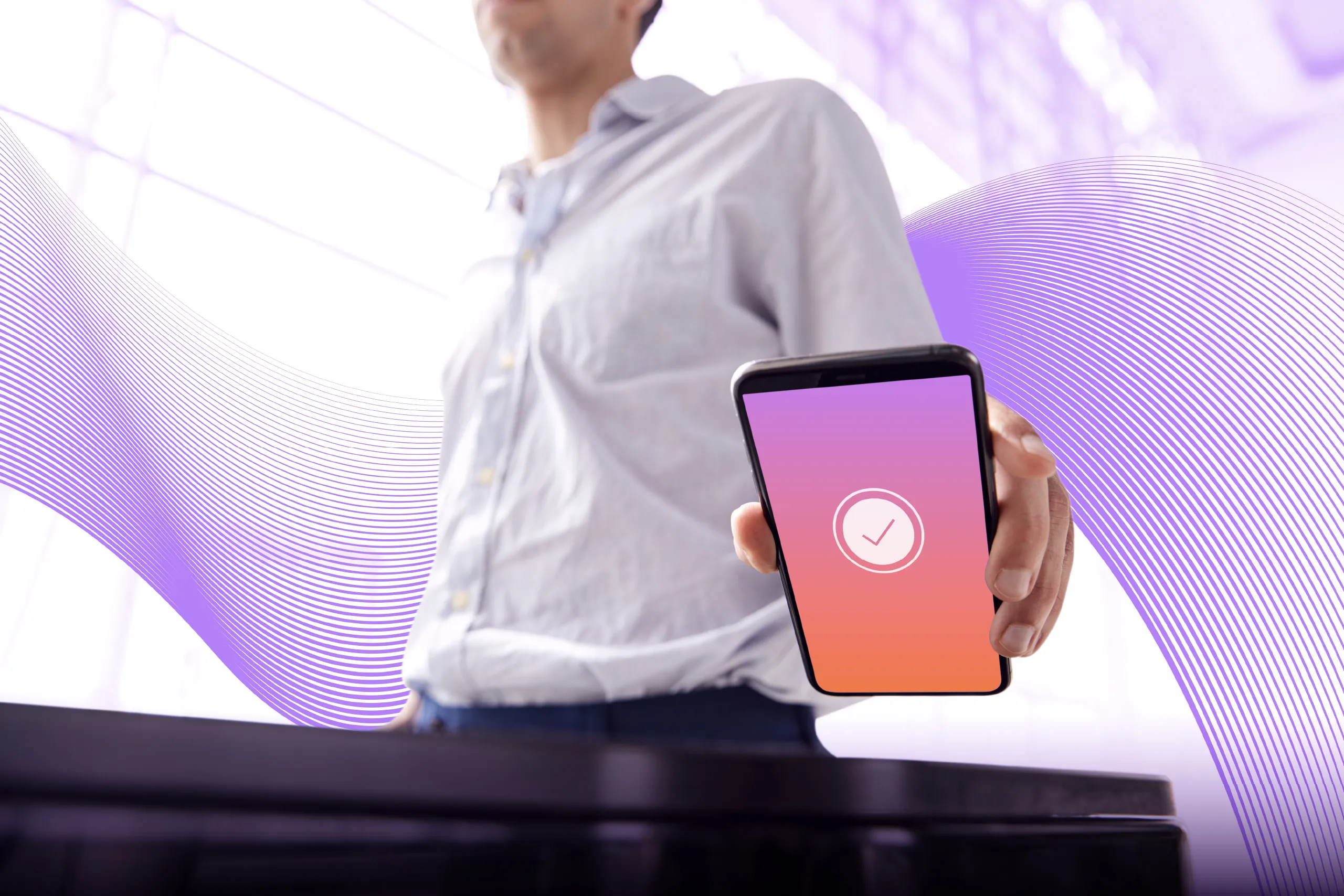In recent years, airport biometrics has significantly transformed the boarding process, improving both traveler experience and security. According to the 2024 IATA Global Passenger Survey, 46% of passengers used biometrics at the airport in 2024. Moreover, 73% of people want to use biometric data instead of passports and boarding passes. Generally speaking, travelers expect more digitalized and streamlined processes.
In this article, we take a close look at how biometric screening at airports is changing ID verification in the travel industry, with real-world examples from leading international hubs.
What is the role of biometrics in airport security?
Airport biometric screening replaces the need for manual identity verification with automated facial recognition, fingerprint scans, and iris recognition. Instead of presenting passports or boarding passes at multiple checkpoints, passengers are identified through biometric data linked to their travel credentials.
This technology has already been integrated into major international airports, including:
Singapore Changi Airport, where 95% of immigration processing will be automated by 2026, allowing passengers to clear security in 10 seconds.
Dubai International Airport, where biometric smart gates now verify travelers at security, immigration, and boarding gates without manual checks.
Abu Dhabi’s Zayed International Airport, which is implementing biometric sensors at every security checkpoint by 2025.
On top of that, airports that are under construction right now, such as King Salman International already have biometric screening systems embedded in their plans.
How airport biometrics improves every step of the passenger journey

Ticket booking
According to the 2024 IATA Global Passenger Survey, 72% of passengers booked most of their flights online. Passengers can register their biometric information through an airline app or at the airport, and this data will be securely stored for future verification.
To set up their profiles, users take a selfie that will be used for identification at the airport and provide a photo of their passport for a one-time data comparison. Once travelers link their boarding passes to their biometric profiles in the app, they can utilize biometric services for their selected flights.
Online check-in
Airports are experimenting with new mobile check-in methods to create a secure process for passengers before their travels. Lufthansa is already testing systems where a passenger's identity is verified via selfie-matching against their passport photo using their mobile app. This means that when a traveler arrives at the airport, they are already verified.
Additionally, airports need to make sure that no inadmissible passenger (INAD) boards a flight. If an INAD passenger does board and then is denied entry at their destination, airlines are heavily fined for the incident. The same goes for ensuring that a passenger is not impersonating someone else by submitting a manipulated image.
For this purpose, Сheckport Switzerland, in cooperation with Regula, developed a solution that performs extensive document checks during online check-in. It also conducts instant facial recognition and prevents fraudulent presentation attacks such as the use of static face images, printed photos, video replays, video injections, or masks—with the help of Regula Face SDK.
Airport check-in
Biometric kiosks are not new, but Tokyo’s Narita Airport has taken them further by removing touchscreens entirely. In early 2025, the airport deployed gesture-controlled biometric kiosks, allowing travelers to check in by standing in front of a screen and navigating through the options with hand movements alone.
Meanwhile, Alaska Airlines has introduced "Face-to-Check-In" at Seattle-Tacoma International Airport, where passengers don’t need to scan a boarding pass or passport at all. The system automatically recognizes registered travelers as they walk up to the check-in zone, pulling up their reservations without any interaction.
Baggage drop/claim
Airports have struggled for years with baggage fraud, where passengers check luggage for someone else under false identities. Facial recognition-matched baggage drops help avoid that: for instance, in Delhi’s Terminal 1 and 3, the new system automatically assigns the baggage to the passenger’s biometric profile, meaning no one can fraudulently claim someone else’s suitcase at the destination.
Security screening
Security checkpoints can sometimes be frustrating for air travel due to long lines, confusion, and the need to remove personal items. Biometric screening at airports has eliminated the need for TSA officers to manually check IDs at security in major U.S. hubs. By early 2025, many major U.S. airports, including Miami, Dallas-Fort Worth, and Chicago O’Hare, will have facial recognition security lanes that validate identity without passengers stopping to show a document.
Shopping
ID verification during traveling can sometimes turn up in unexpected places, even at duty-free shops, for example. Facial recognition technology is increasingly being embraced across airport terminals, extending to duty-free shopping and any other areas where identity verification is necessary.
Many airports are now also adopting biometric technology to facilitate access to exclusive lounges. With biometric entry points, eligible passengers can simply scan their faces to enter lounges, providing greater convenience for frequent flyers.
Boarding
Biometric boarding has become the global standard—as of mid-2024, 98% of airlines have either implemented or are planning to implement biometric systems at their airport terminals.
All the way back in 2017, Amsterdam Schiphol Airport pioneered this movement by introducing "Face-First Boarding", where passengers walk through an automated boarding gate without stopping—their biometric profile confirms their identity, cutting boarding time by 30% per flight.
Since then, many airlines have introduced biometric boarding gates, as it eliminates the need for manual checks of boarding passes and ID verification, reducing wait times and enhancing security.
Immigration control and customs declaration
According to the 2024 IATA Global Passenger Survey, 45% would like to complete all immigration procedures before arriving at the airport. And this is slowly becoming a reality, as travelers will soon be able to verify their identity before the plane even lands.
Dubai’s General Directorate of Residency and Foreigners Affairs (GDRFA) is now considering a biometric pre-arrival immigration clearance system, allowing passengers flying into Dubai to complete facial verification in-flight. This means that when they arrive, they can walk through immigration without stopping.
Get posts like this in your inbox with the bi-weekly Regula Blog Digest!
Main benefits of airport biometrics
Airport biometrics is a multi-purpose solution: not only does it improve airports’ operational efficiency and security, but it also makes travelers more satisfied with otherwise dreaded procedures.

Enhanced security
First and foremost, biometric boarding reinforces airport security by making ID verification virtually foolproof, which has been appreciated by many countries now. For example, the Australian Border Force has successfully trialed facial recognition for contactless international entry, a move expected to expand across all major Australian airports by 2030.
Faster processing
Facial recognition systems at security checkpoints can verify identities in under 10 seconds, eliminating congestion. The U.S. Customs and Border Protection (CBP) Global Entry system has already proven this works. Passengers no longer need to present a passport—instead, they simply stand in front of a facial recognition kiosk, which automatically matches their image to their passport file.
Improved passenger experience
Biometric boarding also makes air travel less stressful:
No fumbling for passports at every checkpoint.
No physical boarding passes that can be lost or misplaced.
No long security lines thanks to automated biometric verification.
According to the 2024 U.S. Travel Association Report, nearly 80% of travelers support biometrics at TSA checkpoints, with most citing time savings and reduced hassle as their primary reasons.
Cost efficiency
Global air passenger traffic is expected to double by 2040, which puts pressure on airports to handle record passenger volumes in the near future. This cannot be achieved without huge investments in expanding physical infrastructure or hiring more workers. However, this pressure can be relieved with biometric boarding, as TSA biometric security lanes at major U.S. airports have cut processing time by 75%, opening the door for more cost-efficient operations.
Fraud prevention
Paper-based travel documents are susceptible to counterfeiting, while manual ID checks depend on human judgment. Biometric authentication removes both of these risks. The European Union’s Entry/Exit System (EES), launching in 2025, will require all non-EU travelers to register biometric data. This system is designed to eliminate fake passports and fraudulent visas by linking every visitor’s identity to their biometric profile.
How Regula Face SDK enables airport biometrics
As biometric boarding grows in adoption, so does the need for advanced solutions to support it. For instance, ID verification and face biometrics checks can be carried out by Regula Face SDK, ensuring convenience and safety at every stage of the journey—from ticket booking to baggage claim.
Our cross-platform biometric verification solution features:
Integration with Airport Systems: The SDK integrates with check-in kiosks, mobile apps, and border control systems, working with existing airport infrastructure.
Advanced Facial Recognition with Liveness Detection: The SDK uses precise facial recognition algorithms with active liveness detection to verify passengers in real time, preventing spoofing through photos or videos.
- 1:1 Face Matching: This matches a passenger’s live facial image to their travel document or database entry, verifying identity at a 1:1 level.
1:N Face Recognition: This scans and compares the passenger’s facial data against a database, identifying them from multiple entries at once (1:N).
Face Attribute Evaluation: This assesses key facial attributes like age, expression, and accessories to improve accuracy and security during identity verification.
Adaptability to Various Lighting Conditions: Operates effectively in almost any ambient light.
Multilingual Support: Available in over 30 languages for easy localization.





